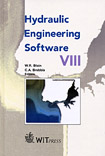Effective Roughness Of Bedforms
Price
Free (open access)
Transaction
Volume
40
Pages
10
Published
2000
Size
897 kb
Paper DOI
10.2495/HY000131
Copyright
WIT Press
Author(s)
M. Li and B.A. O'Connor
Abstract
A CFD model, FLUENT, has been used to study steady turbulent flow over a range of bed forms covering both ripples and dunes. The CFD model with Reynolds stress closure (RSM) is shown to represent the main features of the flow quite well with the error of effective roughness height (&,) within 10% of measured values. The RSM approach was also found to be better than a k-e closure. Use of the CFD model for a series of bedform shapes shows that the prediction of form drag is better represented by methods based on addition of Darcy friction factors (/',/" and/) than by roughness height subdivision (&/, kg and &, ) as suggested by Van Rijn [17]. Engelund's [4] empirical formula for/" was found to be a reasonable fit to the computer data but farther testing is needed, particularly at field scale to confirm these results. 1 Introduction Large-scale bedform
Keywords





